Tobacco: Insect and Nematode Pests Management
Tobacco: Insect and Nematode Pests Management
Gram pod borer/bud worm/capsule borer
BiologyIt is a polyphagous.
- Egg: The spherical, yellowish eggs are laid singly on tender parts and buds of plants. The egg period lasts for 2-4 days.
- Larva: Caterpillars are of varying colour, initially brown and later turn greenish with darker brown lines along the side of the body. The larval period lasts for 18-25 days. Body covered with radiating hairs. When full grown, they measure 3.7 to 5 cm in length. The full grown caterpillar pupates in the soil in an earthen cell and emerges in 16-21 days.
- Pupa: Pupation takes place inside the soil; pupal stage lasts 7-15 days.
- Adult: Moth is stout, medium sized with brownish/greyish forewings with a dark cross band near outer margin and dark spots near costal margins, with a wing expanse of 3.7 cm.
 During the vegetative phase larvae feed on bud leaves and surrounding leaves. During flowering/ capsule formation stage larvae feed on flower buds, flowers and capsules Seeds are eaten severely and completely hollowed out. While feeding the caterpillar thrust its head inside leaving the rest of the body outside.
During the vegetative phase larvae feed on bud leaves and surrounding leaves. During flowering/ capsule formation stage larvae feed on flower buds, flowers and capsules Seeds are eaten severely and completely hollowed out. While feeding the caterpillar thrust its head inside leaving the rest of the body outside.- Bored capsules with round holes.
- Damaged bud leaves, shoots and buds.
- The activity of Helicoverpa starts on green gram, summer vegetables and maize and continues their generation by Oct-Nov months synchronizing with main crop.
Tobacco caterpillar
BiologyIt is found throughout the tropical and sub-tropical parts of the world, wide spread in India. Besides tobacco, it feeds on cotton, castor, groundnut, tomato, cabbage and various other cruciferous crops.
- Egg: Female lays about 300 eggs in clusters. The eggs are covered over by brown hairs and they hatch in about 3-5 days.
- Larva: Caterpillar measures 35-40 mm in length, when full grown. It is velvety, black with yellowish – green dorsal stripes and lateral white bands with incomplete ring – like dark band on anterior and posterior end of the body. It passes through 6 instars. Larval stage lasts 15-30 days
- Pupa: Pupation takes place inside the soil, pupal stage lasts 7-15 days.
- Adult: Moth is medium sized and stout bodied with forewings pale grey to dark brown in colour having wavy white crisscross markings. Hind wings are whitish with brown patches along the margin of wing. Pest breeds throughout the year. Moths are active at night. Adults live for 7-10 days. Total life cycle takes 32-60 days. There are eight generations in a year.
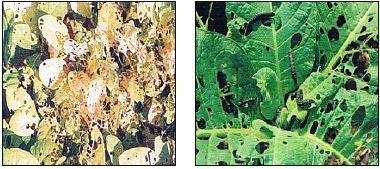 In early stages, the caterpillars are gregarious and scrape the chlorophyll content of leaf lamina giving it a papery white appearance. Later they become voracious feeders making irregular holes on the leaves.
In early stages, the caterpillars are gregarious and scrape the chlorophyll content of leaf lamina giving it a papery white appearance. Later they become voracious feeders making irregular holes on the leaves.- Irregular holes on leaves initially and later skeletonisation leaving only veins and petioles
- Heavy defoliation.
Whitefly
Biology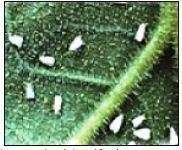 Egg: Pear shaped, light yellowish.
Egg: Pear shaped, light yellowish.- Nymph: On hatching - Oval, scale-like, greenish white.
- Adult: White, tiny, scale-like adult.
- Chlorotic, spotting veins and leaf yellowing, blotching and mosaic of leaves together with leaf curling.
- Vector of tobacco leaf curl disease.
Stem borer
Biology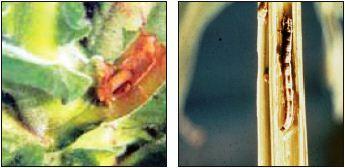 Egg: A female, on an average, lays 50- 80 cylindrical eggs singly more on the upper surface.
Egg: A female, on an average, lays 50- 80 cylindrical eggs singly more on the upper surface.- Larva: In 4th days, eggs hatch and the tiny caterpillars mine along the leaf stalk into the stem and feed on the internal tissues. The full grown larva is pale white in colour, with head and thorax dark brown.
- Pupa: Pupation occurs after 15-22 days. The tunnel is prepared before pupation for exit of adult. Pupation period 2-14 days.
- Adult: Adults are copper red in colour with wing span of 1 cm.
- Larvae bore inside the stem to form a swelling. It causes stunting and unusual branching of the seedlings.
Tobacco aphid
Biology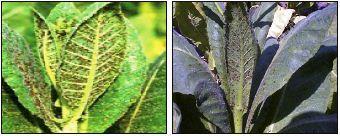 Egg: Eggs are brownish in colour and laid along the veins of leaves.
Egg: Eggs are brownish in colour and laid along the veins of leaves.- Nymph: There are four nymphal stages (instars). The general appearance of each stage is similar except for increase in size during subsequent instars. The first, second, third and fourth nymphal stages last 1-2, 2, 2, and 3 days respectively.
- Adult: Aphids are small, soft-bodied, pearl-shaped insects that have a pair of cornicles (wax-secreting tubes) projecting out from the fifth or sixth abdominal segment. Aphids are pinkish to brown or green colour. Both Apterous (wingless) and alatae (winged) forms pass through 4-5 nymphal instars in their development and the nymphal period ranges from 5-7 days. Both the forms mate within a day or two after the final moult and start reproducing young ones. The Apterous forms produce significantly more number of young ones than alatae but their life-period is shorter than that of alatae. In the field generally viviparous Apterous forms are observed in large number.
- By constantly sucking the sap from leaves they make the plant pale and sickly and thereby retard the growth. They secrete sugary juice known as `honey dew’ on the leaves due to which sooty mould develops rendering the leaves unfit for curing.
Root knot nematode
Biology- Most species of plant parasitic nematodes have a relatively simple life cycle consisting of the egg, four larval stages and the adult male and female.
- Development of the first stage larvae occurs within the egg where the first molt occurs. Second stage larvae hatch from eggs to find and infect plant roots or in some cases foliar tissues.
- Under suitable environmental conditions, the eggs hatch and new larvae emerge to complete the life cycle within 4 to 8 weeks depending on temperature.
- Nematode development is generally most rapid within an optimal soil temperature range of 70 to 80°F.
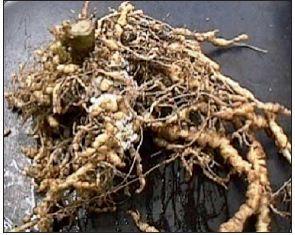 Infected plants in patches in the field
Infected plants in patches in the field- Formation of galls on host root system is the primary symptom
- Roots branch profusely starting from the gall tissue causing a ‘beard root’ symptom
- Infected roots become knobby and knotty
- In severely infected plants the root system is reduced and the rootlets are almost completely absent. The roots are seriously hampered in their function of uptake and transport of water and nutrients
- Plants wilt during the hot part of day, especially under dry conditions and are often stunted
- Nematode infection predisposes plants to fungal and bacterial root pathogens
- Primary: Egg masses in infected plant debris and soil or collateral and other hosts like Solonaceous, Malvaceous and Leguminaceous plants act as sources of inoculums.
- Secondary: Autonomous second stage juveniles that may also be water dispersed.
- Loamy light soils.
IPM for Tobacco
To know the IPM practices for Tobacco, click here.
Source: NIPHM and Directorate of Plant Protection, Quarantine & Storage
Last Modified : 2/13/2020
© C–DAC.All content appearing on the vikaspedia portal is through collaborative effort of vikaspedia and its partners.We encourage you to use and share the content in a respectful and fair manner. Please leave all source links intact and adhere to applicable copyright and intellectual property guidelines and laws.
RELATED ITEMS
Castor: Insect Pests Management
This topic covers the information related to Insec...
Cabbage and Cauliflower Insect pests
This topic covers information about Cabbage and Ca...
IPM for sunflower
This topic covers the information related to Insec...
Cumin: Insect and Nematode Pests Management
This topic covers the information related to Insec...
